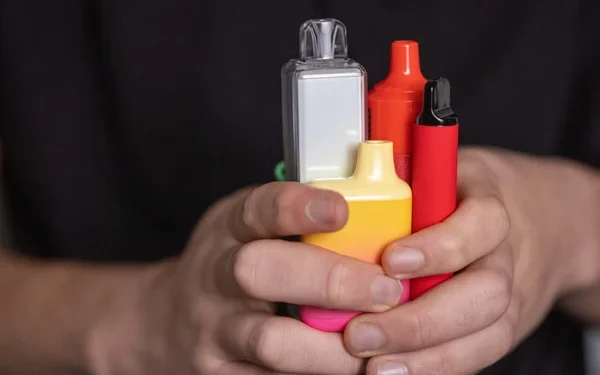Vaping and smoking among young individuals have long raised public health concerns, primarily due to their well-documented physical health consequences. However, recent studies have begun to uncover a more alarming association—the link between vaping, smoking, and mental health problems such as depression and anxiety in adolescents. A new comprehensive study led by researchers at West Virginia University sheds light on this crucial issue, revealing that teens who use tobacco products, particularly e-cigarettes, are significantly more likely to report symptoms of depression and anxiety.
Key Findings: Tobacco Use and Mental Health in Youth
The research, published in the peer-reviewed journal PLOS Mental Health, utilized data from the National Youth Tobacco Survey (NYTS), covering the years 2021 to 2023. This nationally representative survey included responses from 60,072 middle and high school students across the United States, providing robust insights into trends in youth tobacco usage and mental health status.
Among the most striking results:
- 21.31% of students reported using some form of tobacco.
- 9.94% reported using e-cigarettes exclusively.
- 3.61% used traditional tobacco products such as cigarettes, cigars, hookahs, and pipes.
- 7.80% reported dual use—consuming both e-cigarettes and traditional tobacco products.
In terms of mental health:
- 25.21% of respondents reported experiencing symptoms of depression.
- 29.55% reported symptoms of anxiety.
These findings emphasize a troubling correlation: adolescents who use tobacco—especially those who vape—are more likely to experience emotional distress, including feelings of sadness, hopelessness, restlessness, and worry.
Why This Study Matters: A Developmental Perspective
Adolescence is a critical period of physical, emotional, and cognitive development. During these formative years, lifestyle habits—including harmful ones like tobacco use—are often initiated. The researchers emphasize that understanding the connection between substance use and mental health during this stage is essential for early intervention and public health strategies.
Youth who engage in risky behaviors such as vaping are not just exposing themselves to nicotine and other harmful chemicals—they may also be undermining their psychological well-being. According to the study authors, mental health problems during adolescence can have long-term consequences, potentially leading to substance dependence, academic failure, social withdrawal, and increased risk of suicide.
E-Cigarettes vs. Traditional Tobacco: Different Tools, Same Threat
While traditional tobacco use has long been associated with poor mental and physical health, vaping has been marketed as a safer alternative. E-cigarettes are often perceived as less harmful because they lack tar and many of the carcinogens found in combustible cigarettes. However, this perception is misleading and dangerous.
The study indicates that:
- Both vaping and smoking are associated with elevated risks of mental health disorders.
- Dual users—those who use both e-cigarettes and traditional tobacco—tend to show even higher levels of depression and anxiety symptoms than single-product users.
Nicotine and the Adolescent Brain
Nicotine, the addictive chemical found in both cigarettes and most e-cigarettes, is particularly damaging to the developing adolescent brain. It disrupts the function of neurotransmitters, impairs cognitive development, and alters mood regulation systems. Regular nicotine exposure during adolescence has been linked to:
- Increased impulsivity
- Attention deficit symptoms
- Greater susceptibility to addiction
- Long-term changes in emotional regulation
What Makes Vaping Appealing to Teens?
Understanding why so many young people are drawn to vaping is key to curbing the trend. According to prior research and the NYTS, some of the most common reasons adolescents try e-cigarettes include:
- Flavor variety (e.g., fruity, minty, or candy flavors)
- Peer influence
- Perceptions of reduced harm
- Ease of concealment and use in school settings
- Stress relief or self-medication
Unfortunately, the very factors that make vaping appealing to youth are also what make it dangerous. Flavored products can mask the harshness of nicotine, leading to greater consumption and faster development of dependence.
Past Research on Tobacco and Mental Health
The new study aligns with previous findings that link nicotine use with poor mental health outcomes. Historically, smokers have shown higher rates of mood disorders, including:
- Major depressive disorder
- Generalized anxiety disorder
- Bipolar disorder
- Panic attacks
However, much of the earlier research focused on adults and traditional cigarette smoking. This recent study fills a critical gap by specifically examining the impact of vaping and dual usage in adolescents, a group often overlooked in tobacco research.
Public Health Implications and the Need for Intervention
This study holds serious implications for public health policy, education, and mental health intervention. It underscores the urgent need for:
- Stricter regulations on the marketing and sale of e-cigarettes to minors.
- Mental health screenings in schools that include questions about tobacco use.
- Youth-targeted public awareness campaigns highlighting the connection between vaping and mental health problems.
- Early intervention programs that treat both nicotine dependence and underlying mental health conditions.
- Increased parental and educator involvement in identifying early signs of tobacco use and psychological distress.
By addressing the issue early, educators and healthcare professionals can prevent long-term consequences and promote healthier lifestyle choices.
A Call to Action: Supporting Youth Mental Health and Prevention
Parents, teachers, policymakers, and healthcare professionals all have a role to play in reducing youth vaping and smoking rates. Here are a few practical steps that can be taken:
- Educate youth about the risks of nicotine on mental health.
- Encourage open conversations about stress, anxiety, and depression.
- Provide healthy coping mechanisms for dealing with emotional struggles.
- Make cessation resources (such as nicotine patches, counseling, and quitlines) accessible for teens who are already addicted.
- Support school-based wellness programs that promote emotional resilience and mental well-being.
Conclusion: A Holistic View of Teen Health
The findings from the West Virginia University study offer an important reminder: vaping is not just a physical health issue—it is a mental health issue too. As more young people turn to e-cigarettes, possibly in search of social acceptance or emotional relief, the hidden costs become increasingly clear.
With one in four teens showing symptoms of depression and nearly one in three experiencing anxiety, the connection between tobacco use and psychological distress must be addressed. Prevention and early intervention can make a world of difference, protecting not only the lungs but also the minds of the next generation.

























